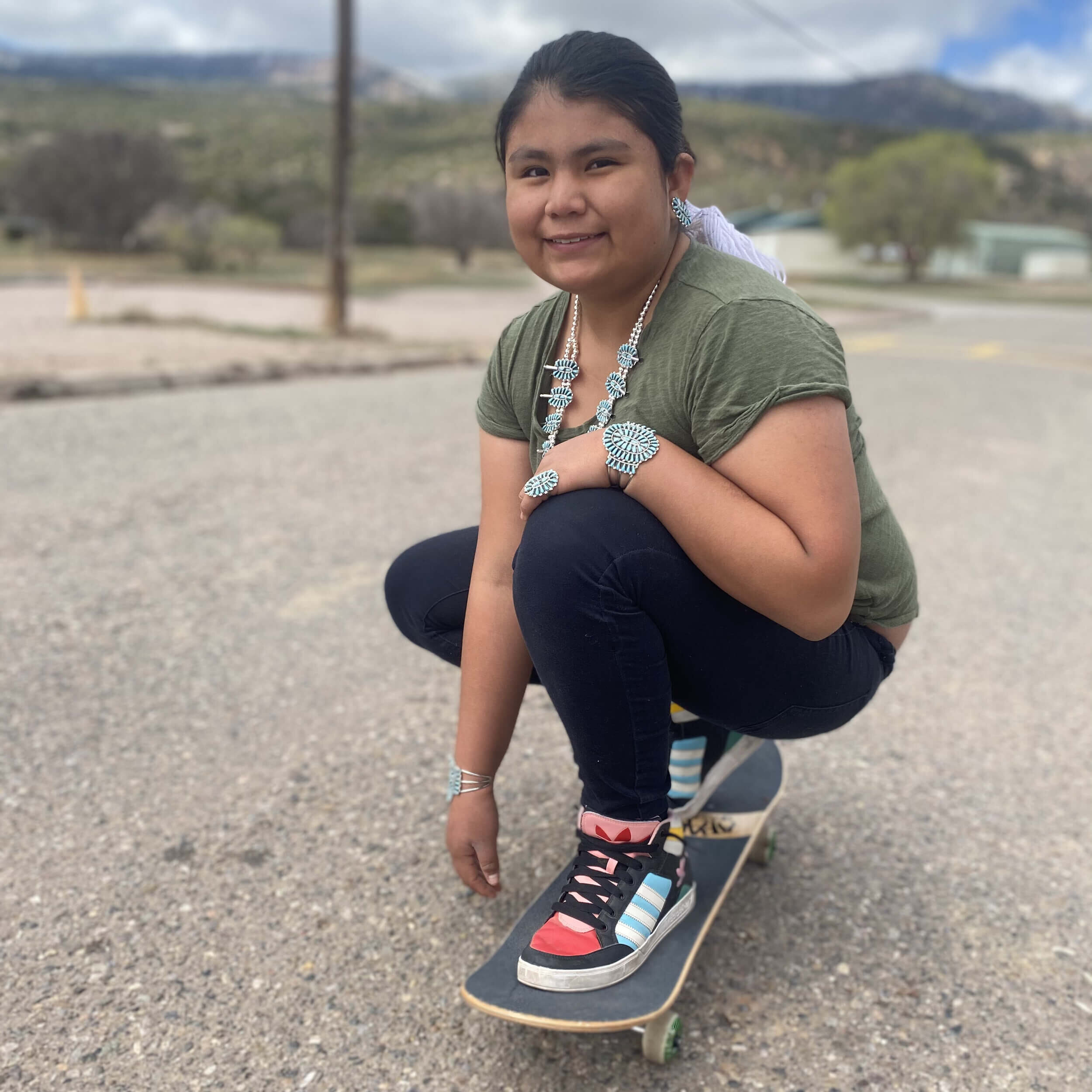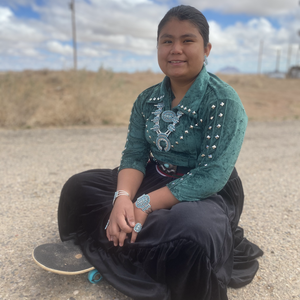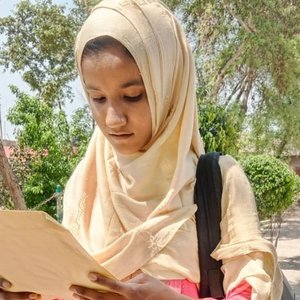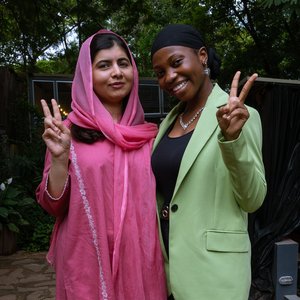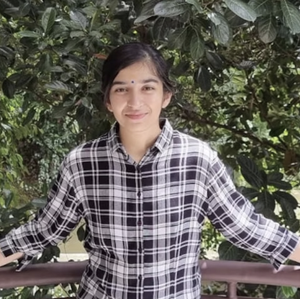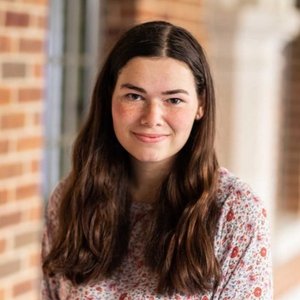The dream of a skate park in the Navajo Nation
(Courtesy of Ciera Charley and 4Kinship)
12-year-old Diné student Ciera Charley shares a photo essay about what a new skate park will mean to Indigenous students in her community.
For young people in the Toadlena — or “Tóhaaliní” (Where the Water flows Out) — community located in the Two Grey Hills chapter of the Navajo Nation, skateboarding is more than a hobby. “Skateboarding is so important to young people in my community,” says Ciera Charley, a 12-year-old Diné student who lives in the area. “It has made life better for Indigenous youth by helping us cope with our problems while letting us exercise and enjoy being kids.”
Encompassing 27,00 miles of land across Arizona, New Mexico and Utah, the Navajo Nation is home to the Diné people, one of the largest federally recognised tribes in the United States. But despite the territory’s breadth, many residents lack access to outdoor sports facilities — especially skate parks. “The Navajo reservation is the size of West Virginia and I only know of five skate parks here,” Diné skateboarder Naiomi Glasses told Teen Vogue. The lack of available skate parks and abundance of dirt and sand roads — which are nearly impossible to skateboard on — make it difficult for girls like Ciera to practise their sport.
This problem inspired the Diné-owned brand 4Kinship to partner with Wonders Around the World, a nonprofit dedicated to making skateboarding more accessible worldwide, to build a skate park in Toadlena/Two Grey Hills, where Ciera lives. Nestled in New Mexico’s Chuska Mountains, Toadlena/Two Grey Hills has no other outdoor sports facility. “Having this skate park will give Indigenous students a place to meet and hang out with their friends in a safe location,” says Ciera. “I think it will bring a lot of happiness and joy to my community.” After the skate park is completed, community leaders also plan to plant seeds in the area and expand the park into a garden where Diné youth and adults alike can practise traditional agriculture and harvesting.
With construction on the skate park set to begin in the fall of 2021, Ciera shares a photo essay about her community in Toadlena/Two Grey Hills and explains how the Diné Skate Garden Project will make skateboarding more accessible to young people in the Navajo Nation.
(Courtesy of Dillon Sachs and 4Kinship)
The Toadlena/Two Grey Hills area where I live is a nice, quiet place with beautiful mountains in the backdrop. It is located at the base of the Chuska Mountains. When you look out from the hill of my school, you see a dry, desert-type of climate to the east but to the west you see the beautiful mountain with trees. The weather and temperature change rapidly as you make your way from the east to the west due to the increase in elevation. At Toadlena/Two Grey Hills there are very little trees and shrubs. It’s more of a desert climate. As you approach Two Grey Hills and the Chuska Mountains you are hitting a forest area with trees and shrubs. It’s a stark contrast because even though the two areas are merely about five miles apart, the weather, terrain and temperature can vary vastly.
(Courtesy of Dillon Sachs and 4Kinship)
If you take walks outside of my home and school you take many different trails on the mountain. You can walk to a waterfall or walk or drive higher in the mountains where you can see different kinds of trees like oak, pine and aspen. It’s not uncommon to see deer walking around the school grounds and even in our yards. There have been sightings of bears at our local apple trees. There is so much wildlife and beauty surrounding our community.
My favorite part of living here is it is a very calming, quiet place to relax. The mountain has many trails so you can see Mother Nature. In the Toadlena/Two Grey Hills area many animals like deer, cows and horses roam the land. It is free and adventurous out here, that is what I love!
(Courtesy of Ciera Charley and 4Kinship)
My first skateboard was given to me by my dad. I was nervous about trying it out at first, so typically I would sit on it and ride downhill. But as I began to see more videos of skateboarders on social media and as my friends and family began participating in the sport, I developed more of an interest. I first started skateboarding a couple of months ago so I am a newcomer to the sport, but I love it already. I believe it helps me with balance, body movement and perseverance. I love how you can feel the cool breeze while riding a skateboard. I feel relaxed and calm not worrying about things. Skateboarding is a way for me to take time for myself and reflect on what has passed and what is to come.
In this photo I am preparing to skateboard after determining there are no cars on the road. Enjoying myself, I ride down a paved road with the Chuska Mountains behind me. When I skateboard, I love to gaze around the beautiful, sandy, brown scenery surrounding the Toadlena/Two Grey Hills area and envision how my community will benefit from the Diné Skate Garden project. I am so excited to soon be able to meet my friends at the skate park. I think it will bring a lot of happiness and joy to my community. I also hope that having a skating park will help me improve my skills because I can watch others skateboard and ask for assistance.
(Courtesy of 4Kinship)
As a youth of the Toadlena/Two Grey Hills community, I am very excited about the Diné Skate Garden Project. Here in the Navajo Nation, most of the roads are dirt and sand, which are not meant to be skateboarded on. Young people can’t skateboard easily outside because we could find ourselves stuck in a sandy bank. If we are lucky enough to live near a paved road we are able to skateboard on the road, but always have to be careful of vehicles driving by. Having this skate park will give Indigenous students a place to meet and hang out with their friends in a safe location and get exercise too. Not only will kids like me enjoy their time there, but also the adults who can work in the garden area. Together all community members can come and enjoy themselves while meeting new people and learning new skills.
(Courtesy of Tomas Karmelo and 4Kinship)
This is Naiomi Glasses, a Diné skateboarder. She has made a significant impact on the skate park project by fundraising and making videos on TikTok so people know about Diné culture and who we are as a people. I am inspired by her because she is so passionate about skateboarding. She models the idea that even though we do not have the ideal conditions for skateboarding in our community, we can be creative in trying new ways to do this activity. In a city or town, streets and empty parking lots exist to skateboard in. We can also skateboard down mesas or find trails with hardened sand to feel like we are participating. Naiomi really cares about helping our Native communities access this sport. I would like to show the same passion and joy in my life — whether it be in sports or academics.
(Courtesy of Ciera Charley and 4Kinship)
Skateboarding is so important to young people in my community because, for some, it helps them cope with the hardships of life. Our community faces many unique challenges which became evident during the pandemic. First is the multigenerational homes many live in. Most homes here on the reservation are not just for a typical family. Rather our homes consist of grandparents, children and grandchildren. Living quarters may be cramped and food limited. Another issue is the distance which we must travel to purchase necessary items or seek services. There are a limited number of grocery stores on the reservation, therefore sometimes we have to think about longevity of food versus the nutrition. In our case in this area we are about 45 minutes away from the nearest grocery store, police and medical center. Many homes are located along dirt roads that are not well maintained. This makes it difficult for emergency workers to get to people quickly when they need help. As we dealt with the COVID-19 pandemic’s disproportionate impact on the Navajo Nation, many of our loved ones fell ill or were taken from us. In New Mexico alone, Indigenous people make up about 10% of the total population but accounted for over half of deaths from COVID-19.
(Courtesy of 4Kinship)
Despite these issues, families work hard and like anyone else, they like to have fun. This is why I think the skate park and garden will be a success. By skateboarding, we have time to stop, think and reflect about what we need to do. Also it allows us to relax and enjoy being outside with other young people. Skateboarding is unique in that it can be done alone or with friends, so whether you’re shy or talkative you can participate. It has made life better for Indigenous youth by helping us cope with our problems while letting us exercise and enjoy being kids. And that’s why I am so excited for the skate park to open. I can’t wait to see my friends, skate and enjoy life with laughter, friendship and support of one another like all young people deserve.
 Read more
Read more



